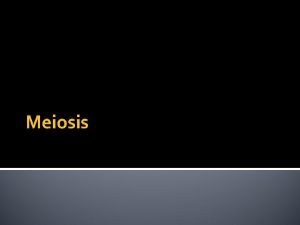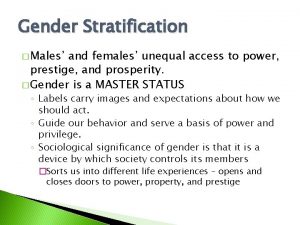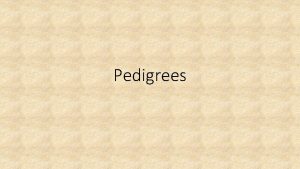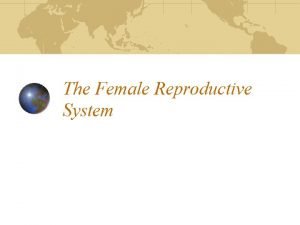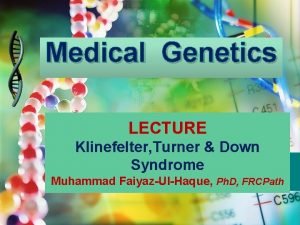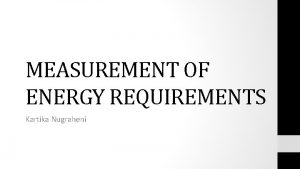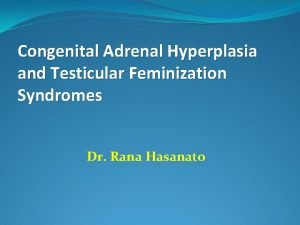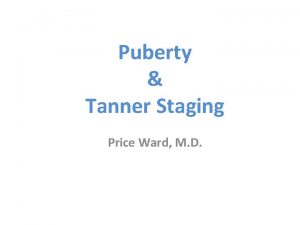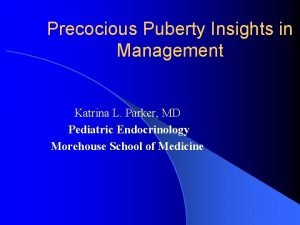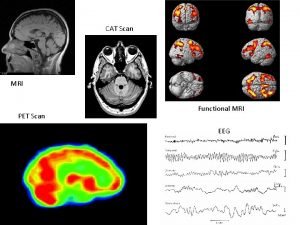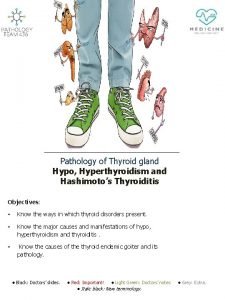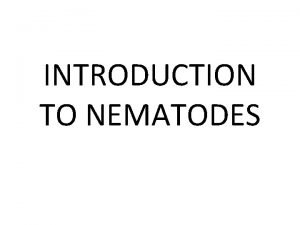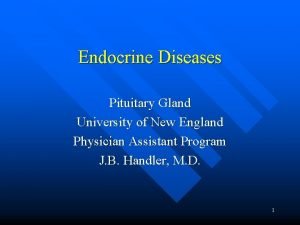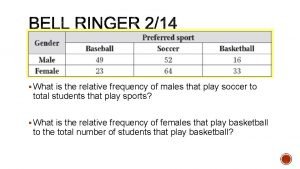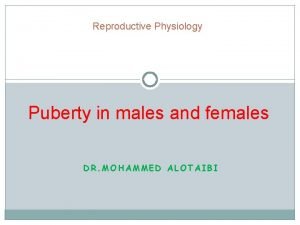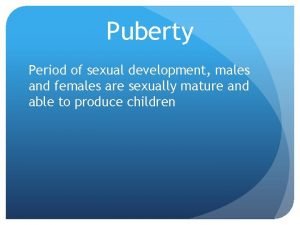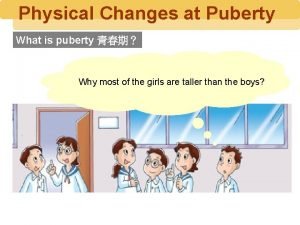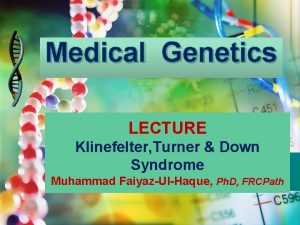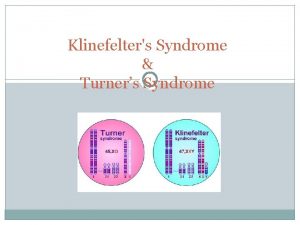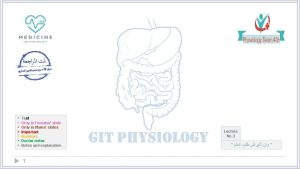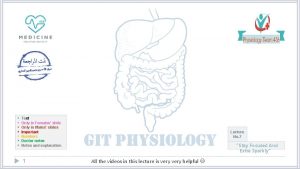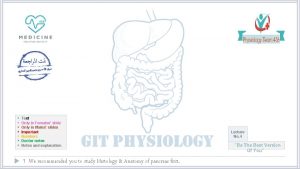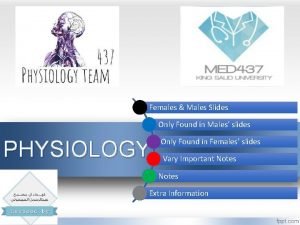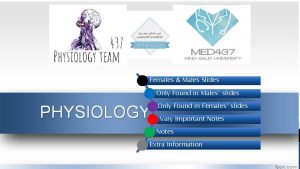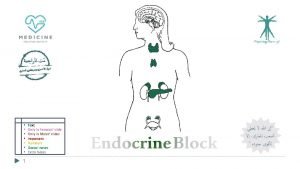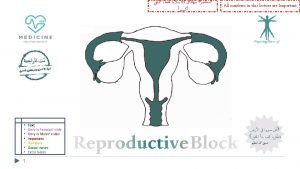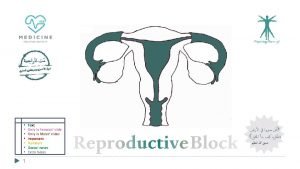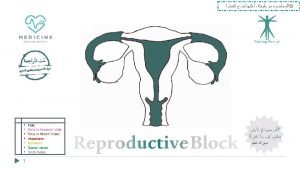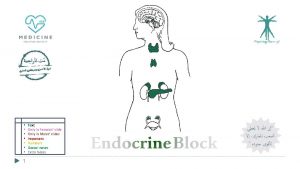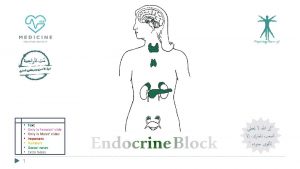Text Only in Females slide Only in Males

























- Slides: 25

§ § § § Text Only in Females’ slide Only in Males’ slides Important Numbers Doctor notes Notes and explanation 1 Lecture No. 11 “What You Plant Today, You Will Harvest Latter”

Physiology of bile salts & enterohepatic circulation Objectives: 1. Functions of the bile and stages of bile secretion. 2. Characteristics of bile. 3. The main constituents of bile. 4. Functions of gall bladder. 5. Differences between hepatic bile and gall bladder bile. 6. Control of biliary system. 7. Primary and secondary bile acids. 8. Enterohepatic circulation of bile salts. 9. Absorption and uptake of bile acids. 10. Functions of bile acids. 2


Only in Males’ Slides Liver ü The liver is the largest internal organ in the body, constituting about 2. 5% of an adult’s body weight. ü Receives 25% of the cardiac output via the hepatic portal vein and hepatic artery. ü Takes up, stores, and distributes nutrients and vitamins. ü Plays an important role in maintaining blood glucose levels. I don’t care about the number & anatomy! Don’t skip it, there is someone else care ü Regulates the circulating blood lipids by the amount of very low-density lipoproteins (LDL) it secretes. ü Synthesizes (Not synthesis) many of the circulating plasma proteins. ü Takes up numerous toxic compounds and drugs from the portal circulation. ü Serves as an excretory organ for bile pigments (Bilirubin wich is very toxic), cholesterol, and drugs. ü Performs important endocrine functions. ü Liver lobule is the basic functional unit of the liver. Liver lobule ü ü ü Hepatocytes form irregular plates arranged in spoke-like fashion. Bile canaliculi carry bile to bile ductules. Bile ductules lead to portal areas. The Liver Receives Most of Its Blood Flow Through the Portal Vein ü ü ü The hepatic portal vein provides about 70% to 80% of the liver’s blood supply, the hepatic artery provides the rest (30 -20%). The portal vein branches repeatedly, forming smaller venules that eventually empty into the sinusoids. The hepatic artery branches to form arterioles and then capillaries, which also drain into the sinusoids. Liver sinusoids can be considered specialized capillaries. The hepatic sinusoids porous and allows the rapid exchange of materials between the perisinusoidal space and the sinusoid. The sinusoids empty into the central veins, which subsequently join to form the hepatic vein, which then joins the inferior vena cava. The Lymphatic System Is Important in Liver Function The hepatic lymphatic system is present in three main areas 1. Adjacent to the central veins 2. Adjacent to the portal veins 3. Coursing along the hepatic artery. ü These channels drain fluid and proteins. The protein concentration is highest in lymph from the liver. 4 space drained by the lymphatic system is the perisinusoidal space. ü The largest ü Disturbances in the balance of filtration and drainage are the primary causes of ascites, the accumulation of serous fluid in the peritoneal cavity.

Hepatocyte Arrangement Aids in the Rapid Exchange of Molecules Only in Males’ Slides 1. Hepatocytes (The most important one) ﻓﻴﻪ ﺳﺆﺎﻝ ﺯﻱ ﺍﻟﻠﻮﺯ ﻣﻦ ﻫﺬﻩ ü Highly specialized cells, the metabolic factories of the liver. ü Their apical membranes are in the form of grooves between adjacent cells, known as canaliculi. ﺍﻟﺴﻼﻳﺪ ü Their tight junctions are relatively permeable to glucose, Ca, glutathione, amino acids and urea. 2. Sinusoidal endothelial cells ü separates the perisinusoidal space (Disse space). ü They lack a basement membrane. They have sievelike plates that permit the ready exchange of materials between the perisinusoidal space and the sinusoid. ü Particles as big as chylomicrons (80 to 500 nm wide) can penetrate these porous plates. 3. Kupffer cells ü Line the hepatic sinusoids and are part of the reticuloendothelial system (monocyte/macrophage). 4. Stellate cells üIn normal condition, they store lipids and vitamin A. üIn inflammatory condition, they become transformed to myofibroblasts, which then become capable of secreting collagen and extracellular matrix into the space of Disse and regulating sinusoidal portal pressure by their contraction or relaxation. ü The Hepatocytes can receive the blood from the perisinusoidal space or space of Disse. ü We get the material and, toxic subunits and waste product from the portal vain. Then all of them get infiltrated. ü After infiltrated they drain into lymphatic vessels. ü Any mistake in filtration we will have portal hypertension, accumulation of fluid in peritoneal cavity (ascites disease). 5

The function of Bile secretion is very important Liver Functions 1. Exocrine (digestive) role The main digestive function of the liver is the secretion of bile (normally 600 -1000 ml/day). Function's of the Bile 1. plays an important role in fat digestion and absorption by the following: • Emulsifying the large fat particles of the food into minute particles. • They aid in absorption of the digested fat end products through the intestinal mucosal membrane, via micells formation. 2. serves as a means for excretion of waste products from the blood. These include especially bilirubin, an end product of hemoglobin destruction. 1. Synthesizes clotting factors and plasma proteins. 2. Metabolizes the organic substances and Cholesterol. Carbohydrate Synthesizes and secrets bile salts. Secrets into the bile a bicarbonate-rich solution Destroys old erythrocytes. Fat metabolism 1. 2. 3. 2. Endocrine role (only in males’) ü Glycogen storage. ü Conversion of galactose and fructose to glucose. ü Gluconeogenesis & many biochemical compounds from carbohydrate. ü B-oxidation of fat to generate ATP. ü conversion of amino acids and two-carbon fragments derived from carbohydrates to fats for storage. ü synthesizes lipoproteins, phospholipids and cholesterols. Bile Secretion Bile is secreted in two stages: The initial portion is continually secreted by the hepatocytes. It is secreted into bile canaliculi that originate between the hepatic cells. Hepatic Bile: Isotonic secretion, with high Na+, Cl- and HCO 3 and low K+ and Ca 2+. 6 2. The bile flows in the canaliculi toward the hepatic duct and common bile duct. From these the bile either empties directly into the duodenum or is diverted for minutes up to several hours through the cystic duct into the gallbladder (this is the second portion of liver secretion which is added to the initial bile). Gallbladder bile: high Bile acid anion and Ca 2+ , but low Na+ , Cl- , HCO 3 When gallblader constrasc, the sphincter of and H 2 O. oddi will be relaxed.

Only in Males’ Slides I’m really care about the modification Bile Modification in the Ductules 7 � The major transport processes of cholangiocytes that secrete an alkaline-rich fluid � The cholangiocytes lining the biliary ductules are specifically designed to modify the composition of bile. Useful solutes, such as glucose and amino acids, are reclaimed by the activity of specific transporters. � Chloride ions in bile are also exchanged for HCO 3 -, thus rendering the bile slightly alkaline and reducing the risk of precipitation of Ca++. � Glutathione is broken down on the surface of cholangiocytes into its constituent amino acids by the enzyme γ-glutamyl transpeptidase (GGT), and the products are reabsorbed. � The bile is also diluted at this site, in concert with ingestion of a meal, in response to hormones, such as secretin, that increase HCO 3 - secretion and stimulate the insertion of aquaporin water channels into the cholangiocyte's apical membrane. � Flow of bile is thereby increased during the postprandial period, when bile acids are needed to aid in assimilation of lipid.

CCK ﻱ ﺑﺎﻟﻚ ﻣﻦ ﺍﻟـ Cont. Bile Characteristic of bile ﺧ ü Bile is a viscous golden yellow or greenish fluid with bitter taste. ü It is isotonic (all GI secretions are Isotonic except salivary, It's hypotonic) with plasma and slightly alkaline with high Na+, Cl-, HCO 3 and low K+ and Ca 2+. Na. HCO 3 in bile is responsible for its alkaline reaction and participates with pancreatic and duodenal secretion in neutralization of acid chyme delivered from stomach (Neutralization of acidic chyme from stomach occurs by the action of 3 secretions: bile, pancreatic & intestinal secretions). Components of bile From hepatocytes Organic constituents: ü Bile acids (bile salts) (65% of dry weight of bile). ü Cholesterol (4%), the major route for cholesterol excretion. ü Phospholipids (Lecithin), phosphatidylcholine(20%). ü Bile pigments (Bilirubin) (0. 3%). ü Ions and water. ü Proteins (5%). From bile ducts Aqueous alkaline Solution (Na. HCO 3) ü Electrolytes mainly HCO 3 - , in addition to H 2 O. ü These contribute to the volume of hepatic bile. ü HCO 3 - aids in neutralization of acid chyme. All of these constituents are secreted by hepatocytes into bile canaliculi, along with an isotonic fluid that resembles plasma in its electrolyte concentration. ü Bile secretion is primarily regulated by a feedback mechanism, with secondary hormonal and neural controls. ü The major determinant of bile acid synthesis is its concentration in hepatic portal blood (feedback control). Regulation of Bile Secretion ü CCK, Secretin and estrogen (hormonal control). ü Parasympathetic and sympathetic nerves supply the biliary system. Parasympathetic (vagal) stimulation results in contraction of the gallbladder and relaxation of the sphincter of Oddi, as well as increased bile formation. Bilateral vagotomy results in reduced 8 bile secretion after a meal, suggesting that the parasympathetic nervous system plays a role in mediating bile secretion.

Functions of gallbladder I’m really care about the modification & storing 1. Gallbladder not only stores bile but it concentrates bile. ü The liver produces about 5 L /day, but the total secretion of bile each day is about 700 -1200 ml per day. ü Bile is secreted continually by the liver cells and then normally stored in the gallbladder until needed in the duodenum (gallbladder can hold 30 -60 ) The maximum volume of the gall bladder. ü Gallbladder concentrates the bile, which has the bile salts, cholesterol, lecithin, and bilirubin during every 12 hours of bile secretion (usually about 450 m. L) because water, Na, Cl, and most other small electrolytes are continually absorbed through the gallbladder mucosa by active transport of sodium, and this is followed by secondary absorption of chloride ions, water, and most other diffusible constituents. ü Bile is normally concentrated in this way about 5 fold, but it can be concentrated up to a maximum of 20 fold. The gall bladder bile & hepatic bile, both of them have low p. H, but the gall bladder rare lower because absorption of Na. HCO 3. Ït's important to have lower p. H in gall bladder, because It has concentrated epithelium. solubilizes as Ca & bilirubin (they can be in stones form) when p. H is low, Ca solubility is high. low p. H prevents forming bile stones. Concentration of bile in the gall bladder occur by: 1. Active absorption of Na+, Cl-, and HCO 3 - by the lining 2. Associated passive water movement out of the lumen. This result in drop of p. H of gall bladder bile due to decreased Na. HCO 3 concentration. . stones ﻷﻦ ﺯﻳﺎﺩﺓ ﺍﻟﺤﻤﻀﻴﺔ ﺗﺰﻳﺪ ﻣﻦ ﺫﻭﺑﺎﻥ ﺍﻟﻜﺎﻟﺴﻴﻮﻡ ﺑﺎﻟﺘﺎﻟﻲ ﺗﺰﻳﺪ ﺗﺠﻤﻊ ﻣﻦ ﺍﻟـ. gallstones ؟ ﻳﻤﻨﻊ ﺗﻜﻮﻳﻦ ﺍﻟـ Ph ﺍﻳﺶ ﻓﺎﺋﺪﺓ ﺍﻧﺨﻔﺎﺽ ﻫﺬﺍ ﺍﻟـ When we need more bile, the bile will secret from both the gallbladder and the liver. This is happen when you eat Mc. Donald’s or ﻣﻔﻄﺢ when Na, Cl, HCO 3 are absorptive by active transported, followed by the osmosis of the water moves from low to high concentrates of Na. 2. Gall bladder epithelium secretes mucus which has protective function(Against low PH of concentrated bile) 3. Buffer of biliary pressure by storing of bile, so it prevents increase in biliary pressure & enables the liver to secret bile, because hepatic cells can not secret against high pressure. If pressure increases, bile secretion will stop ! ﺷﺮﺡ ﺍﻟﺼﻮﺭﺓ ﻓﻲ ﺍﻟﺴﻼﻳﺪ ﺍﻟﺠﺎﻱ 9 . ﻣﻞ ﺑﺲ ﻛﺤﺪ ﺃﻘﺼﻰ 60 ﺗﻘﺪﺭ ﺗﺸﻴﻞ gall bladder ﻭﺃﻦ ﺍﻟـ. 1200 ml ﻳﺴﺎﻭﻱ secretions ﻋﺮﻓﻨﺎ ﻓﻮﻕ ﺃﻦ ﻣﺠﻤﻮﻉ ﺍﻟـ ﻃﻴﺐ ﺍﻟﺒﺎﻗﻲ ﻛﻴﻒ ﺗﻄﻋﻪ؟ ﻛﻴﻒ؟ ، ﺍﺣﻨﺎ ﺍﺫﺍ ﺑﻐﻴﻨﺎ ﻧﻘﻠﻞ ﺣﺠﻢ ﺷﻴﺀ ﻭﺵ ﻧﺴﻮﻱ ﻟﻪ؟ ﻧﺰﻳﺪ ﺍﻟﺘﺮﻛﻴﺰ ﺑﻌﺪﻫﺎ ﺭﺍﺡ ﺗﻠﺤﻘﻬﻢ ﺍﻟﻤﻮﻳﺎ ﺍﻟﺰﺍﻳﺪﺓ ﻋﻦ ﻃﺮﻳﻖ ، ﻋﻦ ﻃﺮﻳﻖ ﺍﻧﻨﺎ ﻧﻤﺘﺼﻬﺎ ﻭﺑﻜﺬﺍ ﻗﻠﻠﻨﺎ ﺍﻷﺠﺴﺎﻡ ﺍﻟﺼﻠﺒﺔ Na+, Cl-, and HCO 3 - ﺍﻟﻠﻲ ﻫﻲ salt ﺭﺍﺡ ﻧﺴﺤﺐ ﺍﻟـ ﻣﻦ ﺍﻟﺘﺮﻛﻴﺰ ﺍﻟﻤﻨﺨﻔﺾ ﺍﻟﻰ ﺗﺮﻛﻴﺰ ﺍﻋﻠﻰ ﻋﺸﺎﻥ ﺗﻌﺎﺩﻟﻪ ﻭﺑﻜﺬﺍ ﻧﻜﻮﻥ ﺯﺩﻧﺎ ﺍﻟﺘﺮﻛﻴﺰ ﻭﺑﺎﻟﺘﺎﻟﻲ ﻗﻞ ﺍﻟﺤﺠﻢ ﻭﻧﻘﺪﺭ ﻧﺨﺰﻧﻪ osmosis ﺍﻟـ

Only in Males’ Slides Cont. 10 � CFTR: Cystic fibrosis transmembrane conductance regulator, chloride channel. � The tight junctions have low permeability, they resist the passage of Bile Acid anions (BA) out of the lumen. � bile enters the ducts and is conveyed toward the intestine. However, in the period between meals, outflow is blocked by constriction of the sphincter of Oddi, and thus bile is redirected to the gallbladder. � The gallbladder is a muscular sac lined with high-resistance epithelial cells. � During gallbladder storage, bile becomes concentrated because sodium ions are actively absorbed in exchange for protons, and bile acids, as the major anions, are too large to exit across the gallbladder epithelial tight junctions. � However, although the concentration of bile acids can rise more than 10 -fold, bile remains isotonic because a single micelle acts as only one osmotically active particle. � Any additional bile acid monomers that become available as a result of concentration are thus immediately incorporated into existing mixed micelles. This also reduces, to some extent, the risk that cholesterol will precipitate from bile. � However, cholesterol is supersaturated in the bile of many adults, with precipitation normally being inhibited by the presence of antinucleating proteins. Prolonged storage of bile increases the chance that nucleation can occur, thus making a good case for never skipping breakfast and perhaps explaining why gallstone disease is relatively prevalent in


Only in Females’ Slides Control of biliary system ﺍﻟﺪﻛﺘﻮﺭ ﺷﺮﺡ ﻣﻮﺿﻮﻉ ﺍﻟﻜﻨﺘﺮﻭﻝ ﺑﺎﺧﺘﺼﺎﺭ ﻋﻠﻰ ﺍﻟﺼﻮﺭﺓ )ﻧﻔﺲ ! ( ﻡ ﺍﻟﺪﻛﺘﻮﺭﺓ ﻛﻼ Ø The human liver secretes bile at a pressure of about 25 cm H 2 O. Ø Between the meals, the choledochoduodenal sphincter is closed offering a resistance of about 30 cm H 2 O. Ø Bile secreted by liver is thus diverted to the gall bladder during the interdigestive peroids. Ø Pressure in the lumen of the gall bladder varies between 0 -16 cm H 2 O. 12

Only in Females’ Slides 1. Secretion of bile by liver cells (choleresis) ü Substances that stimulate hepatic secretion of bile (choleresis) are choleretics. ü The deriving force for bile secretion is active transport of bile acids into canaliculi with passive. H 2 O flow along osmotic gradient. ü In the biliary ducts HCO 3 - is secreted independently of bile acid secretion & is followed passively by water. Bile acid dependent component ü 90% of the rate of secretion of bile acids is determined by the rate of clearance of eabsorbed bile acids from the portal vein via enterohepatic circulation. ü The remaining 10% is due to synthesis of new bile acids by hepatocytes. ü Interruption of the enterohepatic circulation results in markedly reduced choleresis (like portal vein obstruction or resection of terminal part of ileum). ﻣﻬﻢ CCK ﺍﻟـ Bile acid independent component ü This fraction of bile secretion is due to secretion of HCO 3 - , followed by water by the biliary duct cells. It depends on active Na+ transport. It is stimulated by Hormones (the most important one) ü As secretin, glucagon, CCK and gastrin. secretin is the most powerful of them all. ü They all stimulate HCO 3 - & passive water transfer by the biliary duct cells. N. B (not related to hormones only): ü Increase portal blood flow during digestion increases bile secretion. But when the liver is markedly congested bile secretion stops due to increase intrahepatic vascular pressure. 13 ﻡ Don’t skip it! ﺍﻟﺪﻛﺘﻮﺭ ﺷﺮﺡ ﺍﻟﻜﻼ liver cant secret against high pressure. Vagal stimulation ü Stimulates bile flow. ü The effect is mediated mainly indirectly, through stimulation of gastric acid secretion, which leads to release of secretin & CCK. c

2. Control of the discharge of bile into intestine ü Discharge of bile into the duodenum occurs by contraction of gall bladder wall and relaxation of Oddi sphincter. The highest rate of gall bladder emptying occurs during the intestinal phase (When chyme reaches the duodenum). Gall bladder evacuants are called cholagogues (While Choleretics stimulates bile secretion from hepatocytes). ü Discharge of bile into the duodenum is regulated by nervous & hormonal mechanisms. The nervous component ü • • • Parasympathetic (vagal) stimulation results in: Contraction of the gallbladder. Relaxation of the sphincter of Oddi. Increased bile formation. ü N. B: Bilateral vagotomy (Cutting both vagi nerves) results in reduced bile secretion after a meal. ü Stimulation of the sympathetic nervous system results in relaxation of the gallbladder and reduced bile secretion. 14 Only in Females’ Slides ! ﺍﻟﺪﻛﺘﻮﺭ ﺷﺮﺡ ﺍﻟﻤﻮﺿﻮﻉ ﺑﺎﺧﺘﺼﺎﺭ The hormonal component ü The presence of digestive products of fat & proteins releases CCK from the upper intestine into the blood. CCK (The most important Cholagogue) contracts gall bladder and relaxes Oddi sphincter, thus discharging bile into the duodenum. ü Both vagal excitation & secretin augment the action of CCK on the gall bladder.

Only in Females’ Slides Summary of the control (from slides) 15

Bile acids and salts Bile acids are steroid acids, synthesized in the liver from cholesterol by the enzyme cholesterol ( 7α-hydroxylase ) and a carboxyl group are added to the steroid nucleus. Bile acids include Primary Secondary Cholic. Chenodeoxycholic acids. Deoxycholic. Lithocholic acids. Bile Acids Are Formed in the Liver From Cholesterol ü Synthesis by hepatocytes (by C 27 - dehydroxylase), which include cholic acid and chenodeoxycholic acid. ü Bile acids are secreted as conjugates of taurine or glycine. ü When bile enters the GI tract, bacteria present in the lumen act on the primary bile acids and convert them to secondary bile acids by dehydroxylation. ü Cholic acid is converted to deoxycholic acid and chenodeoxycholic acid to lithocholic acid, which is cytotoxic and can be sulfated by the liver if it presents in high concentration. ü At a neutral p. H, the bile acids are mostly ionized and are referred to as bile salts. Conjugated bile acids ionize more readily than the unconjugated bile acids and, thus, usually exist as salts of various cations (e. g. , sodium glycocholate or Sodium taurocholate) and we call it bile salt. ü The conjugation biochemical reaction decreases the p. Ka of the compound and make it more ionized. ü Bile salts are much more polar than bile acids and have greater difficulty penetrating cell membranes (because the membrane contain lipids). ü Consequently, the small intestine absorbs bile salts much more poorly than bile acids. ü This property of bile salts is important because they play an integral role in the intestinal absorption of lipid. ü Therefore, it is important that the small intestine absorb bile salts only after all of the lipid has been absorbed (Bile salts r kept in small intestine until most of fat is digested & absorbed). ü Bile acids are amphipathic that is having both hydrophilic & hydrophobic domains and tend to form molecular arrangement called micelles. ü Bile salts have the ability to form micelles, each bile salt molecule is composed of a sterol nucleus that is fat-soluble and a polar group that is water soluble. ü Micelles are small spherical, cylindrical globules 3 to 6 nm in diameter composed of 20 to 40 molecules of bile salt. ü The polar groups are (-) charged, they allow the entire micelle globule to dissolve in the water of the digestive fluids and to remain in stable solution. ü The micelles act as a transport medium to carry the monoglycerides and free fatty acids to the brush borders of the intestinal epithelial cells. ü In bile acid 16 micelle, the hydrophobic side of bile acid faces inside & away from water. The hydrophilic surfaces outward towards the water.

Cont. Pic is Only in Males’ Slides Only in Females’ Slides ü Bile acids are formed from cholesterol in the liver. ü Bile acids are conjugated with the amino acid, glycine, and taurine (which is an organic compound available in animal tissue) in the liver. ü At neutral p. H, the bile acids are mostly ionized and referred to as bile salts. 17 Extract bile acid from blood > deconjugated > rehydroxylated secondary bile acid (convert secondary bile acid to primary bile acids) > reconjugated > secreted again.

Micelles Formation 18 Only in Males’ Slides

They have a detergent action (emulsifying) on the fat particles in the food which decreases the 1. Digestion of fats surface tension of the particles. They help in the absorption of fatty acids, monoglycerides, cholesterol, and other lipids from the intestinal tract. Bile salts combine with fats to form micelles (water soluble compounds) from which fatty acids, 2. Absorption of fats monoglycerides, cholesterol, and other lipids can be absorbed from the intestinal tract. Function of bile acids Without the presence of bile salts in intestinal tract up to 40% of lipids are lost into the stools (steatorrhea). . ﺍﻭ ﻣﺎ ﺗﻮﺻﻞ ﺍﻟﺒﺎﻳﻞ ﻟﻼﻧﺘﺴﻴﺘﺎﻳﻦ ﺭﺍﺡ ﻳﺪﺧﻞ ﺍﻟﺒﺎﻳﻞ ﻻﻧﻪ ﺩﻫﻨﻲ ، ﻣﻬﻤﺘﻬﺎ ﺑﺲ ﺍﻟﺘﻮﺻﻴﻞ Micelles ﺍﻟـ 3. bile acids are essential for absorption of Vitamins (A, D, E and K). fat soluble Vitamins 4. In the colon bile acids inhibit reabsorption of water & electrolytes, stimulate intestinal motility, prevent constipation & may cause diarrhea. 5. In the liver, bile salts are important for stimulating bile secretion and flow (choleretic action). They also take part in the formation of micells which render cholesterol soluble in bile. 6. Bile acids have a –ve feedback effect on the release of CCK from its cells in the upper intestine & thus contribute to the regulation of pancreatic secretion & the discharge of bile into intestine. (When they reach a certain level , they inhibit secretion of CCK). 7. They have a –ve feedback effect on the synthesis of cholesterol by the intestinal mucosal cells. 19 putrifactive( )ﺗﺨﻤﺮ ﺍﻭ ﺗﻌﻥ : Bile acids have no direct anti septic effect but they prevent putrifaction by absorption of fat. In their absence 8. Anti

Bile Salts Are Recycled Between the Small Intestine and the Liver Hepatocytes extract bile acids, essentially clearing the bile acids from the blood in a single pass through the liver & It is essential for stimulating and maintaining the secretion of bile by hepatocytes. In the Hepatocytes, most deconjugated bile acids are reconjugated & some 2 ry bile acids are rehydroxylated. The reprocessed bile acids, together with newly synthesized bile acids, are secreted into bile, The greater the quantity of bile salts in the enterohepatic circulation, the greater the rate of bile secretion. Enterohepatic Circulation of Bile Salts By cycling several times during a meal, a relatively small bile acid pool can provide the body with sufficient amounts of bile salts to promote lipid absorption (The total amount of bile acids in the body, primary or secondary, conjugated or free, at any time is defined as the total bile acid pool). ü In healthy people, the bile acid pool ranges from 2 to 4 g. The enterohepatic circulation of bile acids in this pool is physiologically extremely important. By cycling several times during a meal, a relatively small bile acid pool can provide the body with sufficient amounts of bile salts to promote lipid absorption. ü in your body you only have 2 -4 g, but in your GI you have 10 times of the normal bile pool, how? by reabsorption. ü Your body only has 2 -4 g but it secreted in your GI then they absorbed again & secreted again, this cycle happens 6 -10 times per day. So in one day the total bile acids were secreted in your GI is 20 -30 g. . recycling ﺯﺍﺩ ﺍﻟـ ، ﻛﻠﻤﺎ ﺯﺍﺩ ، ﻳﻌﻨﻲ ﺍﻟﺴﺎﻳﻜﻞ ﺗﻌﺘﻤﺪ ﻋﻠﻰ ﺍﻟﻔﺎﺕ In a light eater, the bile acid pool may circulate 3 to 5 times a day; in a heavy eater, it may circulate 14 to 16 times a day. The intestine is normally extremely efficient in absorbing the bile salts by carriers located in the distal ileum. Inflammation of the ileum can lead to their malabsorption and result in the loss of large quantities of bile salts in the feces e. g. , inflammatory bowel diseases (Crohn’s disease & Ulcerative Colitis) . Depending on the severity of illness, malabsorption of fat may result and steatorrhea* (fat in stool) because bile salt pool was depleted following the ileal inflammation or resectioning. Presence of bile salt in the colonic lumen will activate Cl secretion, Na and water will follow Cl into the intestinal lumen, producing secretory diarrhea (Excess amount of bile acids entering the colon may result in diarrhea). Diarrhea Because it increases intestinal motility. Bile salts or bile acids in the intestine lumen are absorbed via four pathways into portal circulation (enterohepatic circulation): 1. Passive diffusion 2. An active carrier-mediated process. 3. De-conjugation and/or transforming of bile salts to bile acids (by bacteria). 20 4. Transforming the primary bile acids to *secondary acids (by Steatorrheabile is loss of fat in stool bacteria). caused by interruption of hepatic circulation or insufficient bile salts or deficiency of pancreatic.

Enterohepatic Circulation of Bile Salts About 20 -30 g of bile acids are poured into the duodenum /day. Only in Females’ Slides In the intestine, some of bile acids are deconjugated and dehydroxylated in the 7 α position by intestinal bacteria that normally colonize in the digestive tract. Dehydroxylation results in the production of secondary bile acids. Cholic acid is converted to deoxycholic acid and chenodeoxycholic acid to lithocholic acid. On reaching the terminal ileum, about 95% of bile acids are absorbed and reach the liver through the portal vein. About 0. 3 -0. 5 g of bile acids are lost in feces daily (15 -35% of total bile acid pool). These are replaced by new synthesis in liver so that the total bile acid pool is maintained constant at 2 - 4 g. Since the amount of bile acids poured into the duodenum each day is 20 -30 g, the daily turnover of total bile acid pool through the enterohepatic circulation must be 6 -10 times. 21

Absorption of bile acids in intestinal lumen Bile acids are absorbed largely in the terminal part of the ileum. They cross the brush border plasma membrane by two routes: 1. Active transport process. It is 2 ry active transport (Sodium cotransport) powered by the Na+ gradient across the brush border membrane. Simple diffusion. ü The conjugated bile acids are the principal substrates for active absorption. ü Unconjugated bile acids have poor affinity for the transporter. They are less polar than conjugated bile acids, they are better absorbed by simple diffusion. ü Bile acids may be bound to proteins, (which remain to be identified), in intestinal epithelial cells. ü Absorbed bile acids are carried away from the intestine in the portal blood, mostly bound to albumins. N. B: ü In the small intestine, cholic acid is absorbed faster than chenodeoxycholic acid, and primary bile acids are absorbed better than secondary bile Bileacids. salts or bile acids in the portal circulation are absorbed via four pathways into hepatocytes: 1. An active carrier-mediated process: conjugated ü Some unconjugated bile acids are absorbed passively in the colon and reach the liver through portal vein. bile acids-Na co-transport. 2. Na-independent pathway. 3. Bile acid-HCO 3 or Bile acid-OH exchange. 4. Passive diffusion (very little). 22

Only in Females’ Slides Summary (from slides) 23

Only in Females’ Slides Cholesterol secretion in bile � About 1 -2 g of cholesterol appears in bile per day. � No specific function is known for cholesterol in the Bile & it is presumed that it is simply a by product of Bile salt formation & secretion. � Cholesterol is water insoluble; it is solubilized by incorporation in micelles along with the bile acids & phospholipid. ﺗ ﺑﺤﻤﺪ ﺍﻟﻠﻪ ﻭﺗﻮﻓﻴﻘﻪ ﻭﺗﻴﺴﻴﺮﻩ Best of the luck 24

Thank you!. ﺍﻋﻤﻞ ﻭ ﺃﻨﺖ ﺗﻌﻠﻢ ﺃﻦ ﺍﻟﻠﻪ ﻻ ﻳﻀﻴﻊ ﺃﺠﺮ ﻣﻦ ﺃﺤﺴﻦ ﻋﻤﻼ ، ﺍﻋﻤﻞ ﻟﺘﻤﺴﺢ ﺩﻣﻌﺔ ، ﺍﻋﻤﻞ ﻟﺘﺮﺳﻢ ﺑﺴﻤﺔ The Physiology 436 Team: Team Leaders: Females Members: Laila Mathkour Mohammad Alayed Mohammad Ebtisam Nusser Alsugyani Qais Almuhaideb Nada Aldakheel References: • • Zaina Alkaff 2017 -2018 Dr. Hayam Gad’s Lecture & notes. 2017 -2018 Dr. Mohammed Al Zoghaibi’s Lecture & notes. Guyton and Hall Textbook of Medical Physiology (13 th Edition). Bern & Levy physiology (6 th Editition). 25 . ﻓﺮﺩﻩ ﻟﻲ ﻭﻗﺖ ﺣﺎﺟﺘﻲ ﺇﻟﻴﻪ ﺇﻙ ﻋﻠﻰ ﻛﻞ ﺷﻴ ﻗﺪﻳﺮ ، ﺍﻟﻠﻬﻢ ﺍﻧﻲ ﺍﺳﺘﻮﺩﻋﺘﻚ ﻣﺎ ﺣﻔﻈﺖ ﻭﻣﺎ ﻗﺮﺃﺖ ﻭﻣﺎ ﻓﻬﻤﺖ Contact us:
 Http://www.cellsalive.com/meiosis.htm
Http://www.cellsalive.com/meiosis.htm The unequal access of males and females to property
The unequal access of males and females to property Making connections images
Making connections images Toe and heel dance
Toe and heel dance What is a pedigree?
What is a pedigree? How many immature eggs are females born with
How many immature eggs are females born with Shield chest
Shield chest Rumus bee
Rumus bee Fbla dress code
Fbla dress code Virilisation in females
Virilisation in females Puberty stage 1
Puberty stage 1 Tanner scale
Tanner scale Nageeb thought all nurses
Nageeb thought all nurses Thyroid issues in women
Thyroid issues in women In nemathelminthis females are
In nemathelminthis females are In 1971 there were 294 105 females
In 1971 there were 294 105 females High prolactin levels symptoms
High prolactin levels symptoms What is the ffa code of ethics
What is the ffa code of ethics What is the relative frequency for males ?
What is the relative frequency for males ? Fritz haarmann childhood
Fritz haarmann childhood Puberty
Puberty Male puberty
Male puberty Por que dos males ha hecho mi pueblo
Por que dos males ha hecho mi pueblo Is puberty a physical or chemical change
Is puberty a physical or chemical change Turner syndrome in males
Turner syndrome in males Kleinfelters
Kleinfelters
